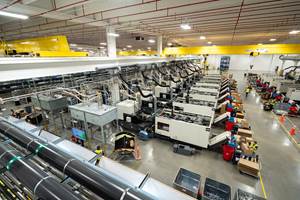Infrastructure May Prove Big Landing Spot for Recycled Plastics
As the government funds infrastructure improvements, a hot topic at NPE2024 – exploration of the role recycled plastics can play in upcoming projects, particularly road development.
For decades, plastics have proven themselves as viable materials in building and construction. Industry veterans may recall the concept house GE Plastics (now SABIC) built in Pittsfield, Massachusetts, in 1989 to demonstrate possible applications for plastics in homes.
“The plastics industry ... is in a prime position to contribute to our nation’s infrastructure needs. From improved recovery facilities to uses in pavements and pipes, plastics can play a role.”
– The Plastics Industry Association, Producer of
This model suburban home showed liquid crystal plastic windows that could change from transparent to opaque at the flick of a switch. Cutaway cross sections showed possible plastic construction concepts, including modular plumbing panels and snap-on plastic wall sections.
Today, of course, plastics is a staple in construction, used in plumbing, decks, windows, siding, fencing and a lot more.
Lurking, though, is a new opportunity in which two burgeoning opportunities converge: infrastructure development and recycled plastics. Passed in 2021, The Infrastructure Investment and Jobs Act earmarks $550 billion over fiscal years 2022 through 2026 in new federal investment in infrastructure projects that include roads, bridges and mass transit, water infrastructure and broadband.
As the points out, “The plastics industry ... is in a prime position to contribute to our nation’s infrastructure needs. From improved recovery facilities to uses in pavements and pipes, plastics can play a role. The infrastructure policies we advocate for create jobs, protect the environment and improve our daily lives.”
VISIT:
More on pavements: Research is underway to determine whether recycled plastics can play a role in some upcoming infrastructure projects, particularly road development. According to an article in , multiple states are testing whether asphalt roads mixed with discarded bags, bottles and other reclaim can make pavement last longer, save money and reduce the amount of waste that ends up in landfills. The article noted that in Missouri a pilot program is being conducted on a busy highway made of asphalt mixed with pelletizing bottle flake, and that California is testing a road made of a mixture of asphalt and 10% scrap from printer cartridges.
Meantime, in a white paper commissioned by the National Academies of Sciences, Engineering, and Medicine (NASEM), Stanford University engineers Michael Lepech and Zhiye Li studied the current status, challenges and needs of recycling plastics in a circular economy, and examined the long-term durability and environmental costs of doing so for use in infrastructure.
Notes Li, in an article that appeared on the , “Upcycling of recycled plastics in infrastructure sets an example of creating value by creating demand. The recycled plastic-blended construction material needs to achieve certain performance requirements and maintain lower environmental impacts than conventional construction materials. Our paper shows that for a use case that has a longer life span — such as certain blended plastic composite building panels or asphalt pavement — the needed quality and sustainability requirements are more achievable. Upcycling plastic waste in infrastructure has attracted increasing interest because it creates something of high value for which there is large potential demand.”
Last year, meantime, reported that the National Academies of Sciences, Engineering and Medicine issued a report in which it recommended how the Environmental Protection Agency and the Department of Transportation join forces to promote and sustain a coordinated government response to end-of-life plastics in the U.S. that includes assessments of using recycled plastics in infrastructure.
Related Content
Advanced Drainage Systems to Build New Florida Manufacturing Facility
New manufacturing facility will complement other ADS facilities in the southeast region.
Read MoreEV Chargers Made From Renewable PC
SABIC is enabling Charge Amps to manufacture electric vehicle (EV) chargers with a housing made from certified renewable PC, a first for the industry.
Read MoreIPEX Opens Injection Molding Facility in North Carolina
The pipe and fittings manufacturer’s new 200,000-square-foot facility represents a $200 million investment and will create 150 jobs.
Read MorePTXPO Recap: Turning E-Waste into Durable Building Materials
Check out what you missed on the PTXPO show floor. Canon and Repolytex showcased a unique solution that skips the costly and complex plastic separation process entirely.
Read MoreRead Next
Making the Circular Economy a Reality
Driven by brand owner demands and new worldwide legislation, the entire supply chain is working toward the shift to circularity, with some evidence the circular economy has already begun.
Read MorePeople 4.0 – How to Get Buy-In from Your Staff for Industry 4.0 Systems
Implementing a production monitoring system as the foundation of a ‘smart factory’ is about integrating people with new technology as much as it is about integrating machines and computers. Here are tips from a company that has gone through the process.
Read More











